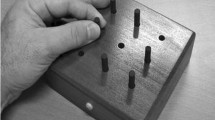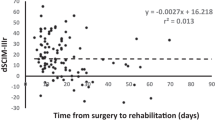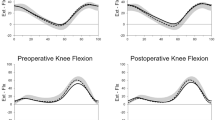Abstract
Purpose
This study aimed to evaluate the effects of surgery on locomotor ability in patients with cervical spondylotic myelopathy (CSM) and compare the results between elderly and younger patients.
Methods
A total of 369 consecutive patients who underwent expansive laminoplasty for CSM were prospectively analysed. Patients were divided into two age groups of ≥75 years (elderly group, 76 patients) and <75 years (younger group, 293 patients). Locomotor ability was estimated using part of the functional independence measure (FIM). The sum of gait and stairs items [functional independence measure (locomotion), FIM-L; possible scores, 2–14] and neurological status were estimated using the Japanese Orthopaedic Association (JOA) score (possible score, 0–17). Pre-operative neurological anamnesis was reviewed, and the surgical results of elderly patients with or without co-existing neurological history were evaluated to determine the origin of locomotor disability.
Results
Peri-operative FIM-L and JOA scores were significantly lower in the elderly group than in the younger group, and the opposite was true for improved FIM score. Cerebral infarction and previous lumbar surgery were identified as neurological co-morbidities in the elderly group. However, there was no significant difference in surgical results between elderly patients with and without co-existing neurological disorders.
Conclusions
Decompression surgery can improve locomotor ability and decrease nursing care requirements among elderly patients with CSM. However, other neurological diseases can co-exist in elderly patients, making it difficult to diagnose the origin of locomotor disability. Therefore, detailed peri-operative work-up and timely decompression should be given priority to avoid progression towards fixed locomotor disability.



Similar content being viewed by others
References
Matsuda Y, Shibata T, Oki S, Kawatani Y, Mashima N, Oishi H (1999) Outcomes of surgical treatment for cervical myelopathy in patients more than 75 years of age. Spine 15:529–534
Naderi S, Ozgen S, Pamir MN, Ozek MM, Erzen C (1998) Cervical spondylotic myelopathy: surgical results and factors affecting prognosis. Neurosurgery 43:43–49 (discussion 49–50)
Holly LT, Moftakhar P, Khoo LT, Shamie AN, Wang JC (2008) Surgical outcomes of elderly patients with cervical spondylotic myelopathy. Surg Neurol 69:233–240
Paffenbarger RS Jr, Hyde RT, Wing AL, Hsieh CC (1986) Physical activity, all-cause mortality, and longevity of college alumni. N Engl J Med 314:605–613
Brach JS, FitzGerald S, Newman AB, Kelsey S, Kuller L, VanSwearingen JM, Kriska AM (2003) Physical activity and functional status in community-dwelling older women: a 14-year prospective study. Arch Intern Med 163:2565–2571
Granger CV, Hamilton BB, Linacre JM, Heinemann AW, Wright BD (1993) Performance profiles of the functional independence measure. Am J Phys Med Rehabil 72:84–89
Keith RA, Granger CV, Hamilton BB, Sherwin FS (1987) The functional independence measure: a new tool for rehabilitation. Adv Clin Rehabil 1:6–18
Japanese Orthopaedic Association (1994) Scoring system (17-2) for cervical myelopathy. J Jpn Orthop Assoc 68:490–503
Nurick S (1972) The pathogenesis of the spinal cord disorder associated with cervical spondylosis. Brain 95:87–100
Singh A, Crockard HA (1999) Quantitative assessment of cervical spondylotic myelopathy by a simple walking test. Lancet 354:370–373
Yukawa Y, Kato F, Ito K et al (2008) “Ten Second Step Test,” as a new quantifiable parameter of cervical myelopathy. Spine 34:82–86
Satomi K, Nishu Y, Kohno T, Hirabayashi K (1994) Long-term follow-up studies of open-door expansive laminoplasty for cervical stenotic myelopathy. Spine 19:507–510
Yamazaki T, Yanaka K, Sato H, Uemura K, Tsukada A, Nose T (2003) Cervical spondylotic myelopathy: surgical results and factors affecting outcome with special reference to age differences. Neurosurgery 52:122–126
Nagashima H, Dokai T, Hashiguchi H et al (2011) Clinical features and surgical outcomes of cervical spondylotic myelopathy in patients aged 80 years or older: a multi-center retrospective study. Eur Spine J 20:240–246
Machino M, Yukawa Y, Hida T et al (2012) Can elderly patients recover adequately after laminoplasty?: a comparative study of 520 patients with cervical spondylotic myelopathy. Spine 37:667–671
Tani T, Yamamoto H, Kimura J (1999) Cervical spondylotic myelopathy in elderly people: a high incidence of conduction block at C3–4 or C4–5. J Neurol Neurosurg Psychiatry 66:456–464
Tani T, Ishida K, Ushida T, Yamamato H (2000) Intraoperative electroneurography in the assessment of the level of operation for cervical spondylotic myelopathy in the elderly. J Bone Jt Surg (Br) 82:269–274
Mihara H, Ohnari K, Hachiya M, Kondo S, Yamada K (2000) Cervical myelopathy caused by C3–C4 spondylosis in elderly patients: a radiographic analysis of pathogenesis. Spine 25:796–800
Tani T, Kawasaki M, Taniguchi S, Ushida T (2003) Functional importance of degenerative spondylolisthesis in cervical spondylotic myelopathy in the elderly. Spine 28:1128–1134
Kato Y, Kojima T, Kataoka H, Imajo Y, Yara T, Yoshida Y, Imagama T, Taguchi T (2009) Selective laminoplasty after the pre-operative diagnosis of the responsible level using spinal cord evoked potentials in elderly patients with cervical spondylotic myelopathy: a preliminary report. J Spinal Disord Tech 22:586–592
Scardino FB, Rocha LP, Barcelos AC, Rotta JM, Botelho RV (2010) Is there a benefit to operating on patients (bedridden or in wheelchairs) with advanced stage cervical spondylotic myelopathy? Eur Spine J 19:699–705
Rajshekhar V, Kumar GS (2005) Functional outcome after central corpectomy in poor-grade patients with cervical spondylotic myelopathy or ossified posterior longitudinal ligament. Neurosurgery 56:1279–1284
Edwards WC, LaRocca SH (1985) The developmental segmental sagittal diameter in combined cervical and lumbar spondylosis. Spine 10:42–49
Dagi TF, Tarkington MA, Leech JJ (1987) Tandem lumbar and cervical spinal stenosis: natural history, prognostic indices, and results after surgical decompression. J Neurosurg 66:842–849
Epstein NE, Epstein JA, Carras R, Murthy VS, Hyman RA (1984) Coexisting cervical and lumbar spinal stenosis: diagnosis and management. Neurosurgery 15:489–496
Lee MJ, Garcia R, Cassinelli EH, Furey C, Riew KD (2008) Tandem stenosis: a cadaveric study in osseous morphology. Spine J 8:1003–1006
Tsutsumimoto T, Shimogata M, Yui M, Ohta H, Misawa H (2012) The natural history of asymptomatic lumbar canal stenosis in patients undergoing surgery for cervical myelopathy. J Bone Joint Surg Br 94:378–384
Conflict of interest
None of the authors of this manuscript has received any type of support, benefits or funding from any commercial party related directly or indirectly to the subject of this article.
Author information
Authors and Affiliations
Corresponding author
Rights and permissions
About this article
Cite this article
Yoshida, G., Kanemura, T., Ishikawa, Y. et al. The effects of surgery on locomotion in elderly patients with cervical spondylotic myelopathy. Eur Spine J 22, 2545–2551 (2013). https://doi.org/10.1007/s00586-013-2961-8
Received:
Revised:
Accepted:
Published:
Issue Date:
DOI: https://doi.org/10.1007/s00586-013-2961-8




